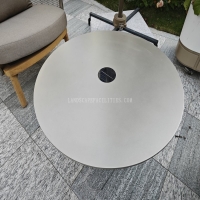Welcome to the website for landscape facilities products and knowledge.
How does the Landscape Round Table support the trend toward more democratic or flat organizational structures?
The contemporary business landscape is witnessing a significant shift away from traditional, hierarchical pyramids toward more fluid and democratic organizational models. In this transformation, the concept of the Landscape Round Table emerges as a powerful architectural and philosophical framework supporting this trend. Unlike the conventional boardroom table that reinforces status and hierarchy, the Landscape Round Table is designed to be a literal and metaphorical leveler.
Fundamentally, the Round Table dismantles physical and psychological barriers. By removing a designated "head," it creates an environment where every participant has an equal seat and an equal voice. This spatial democracy directly challenges the top-down communication flow of classic hierarchies. When a CEO sits as an equal among interns and mid-level managers, it sends a clear message: authority is derived from insight, not just title. This fosters a culture of psychological safety, where employees feel empowered to contribute ideas, challenge assumptions, and share feedback without fear of reprisal. The round table is not just a piece of furniture; it is a symbol of inclusivity and collective intelligence.
This structural shift is operationalized through collaborative decision-making. The Landscape Round Table facilitates dynamic discussions where problem-solving becomes a shared responsibility. Instead of directives flowing downward, strategies are co-created through a process of dialogue and consensus-building. This approach leverages the diverse expertise present across the organization, leading to more innovative and robust solutions. It accelerates the flow of information, as communication is no longer bottlenecked by managerial layers. Employees are no longer mere executors of tasks but become active stakeholders in the company's direction, which dramatically enhances engagement and ownership.
Furthermore, the Landscape Round Table model promotes transparency and accountability. In a flat structure nurtured by such a forum, information is shared more openly. The discussions held around this table often set the tone for the entire organization, modeling transparent communication and making the rationale behind decisions clear to all participants, who then disseminate this understanding. This transparency builds trust and ensures that everyone is aligned with the organizational vision. Accountability becomes a collective endeavor, with teams holding each other responsible for outcomes rather than relying on a single manager for oversight.
In conclusion, the Landscape Round Table is far more than a trend in office design. It is a critical enabler of democratic organizational structures. By physically embodying the principles of equality, open collaboration, and shared leadership, it provides a practical platform for companies to flatten their hierarchies, empower their workforce, and build a more resilient, agile, and innovative enterprise for the future.
Related search:

Recommendation
Outdoor stainless steel table with solar-powered ambient lighting feature - excellent design.